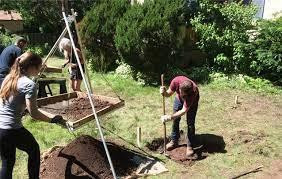More from bluestone research
More in Politics
Related Blogs
Les archives
Partage Social
Revealing the Past: Handling Archaeology in Cultural Resource Management
Corps
Archaeology for Cultural Resource Management (CRM) is an exciting area that is important to the protection of our cultural legacy. There are the four main steps of a methodical procedure that are involved. We will examine each phase in this investigation to determine the value of CRM archaeology in solving the enigmas surrounding our cultural history.
Background Assessment in Stage 1
Envision setting off on a historical expedition, where the first stage is to comprehend the background of the tale you will soon be telling. This is the main goal of CRM archaeology's Stage 1 Background Assessment. To learn more about a location's history, topography, and cultural value, archaeologists conduct in-depth investigations. They prepare the way for the next steps by looking over historical documents, maps, and earlier studies.
This exploratory study acts as a compass, pointing archaeologists in the direction of possible cultural materials. Finding locations that could be in danger as a result of upcoming development projects is the aim. CRM archaeologists preserve our cultural legacy and make sure no hidden gems are missed by doing a comprehensive background examination.
Property Evaluation Stage 2
After laying the foundation, Stage 2: Property Assessment is reached. To locate any possible archaeological sites, a thorough survey of the defined region is conducted during this phase. They use a variety of methods to find hidden buildings or residue under the surface including aerial photography, geophysical surveys, and field surveys.
Decision-makers may use this inventory as a useful tool to assist those balances development and preservation. Archaeologists aid in well-informed decision-making that takes the cultural value of the environment into account by charting possible locations.
Site-Specific Evaluation in Stage 3
Archaeologists may get closer to discovering the mysteries buried under the surface of the earth by completing the Stage 3 Site Specific Assessment after they have a list of possible locations. At this point, certain sites are the subject of more thorough examinations to ascertain their historical and archaeological significance. Test digs are a possible activity for archaeologists, who gather samples and artefacts to examine their age, provenance, and importance.
The data acquired in Stage 3 informs choices on the degree of security needed for each site. Certain sites could be judged necessary for preservation, while others would be appropriate for carefully managed excavation.
Excavations in Stage 4
An excavation is when the CRM archaeological odyssey comes to a close. Here, archaeologists dig for riches buried under the ground with caution and an open mind. A practical way to learn about artefacts, buildings, and other historical relics is via excavations. Every layer of soil exposes a new historical chapter and provides insights into the customs, innovations, and lives of the past.
Stage 4 - Excavations need to be done carefully and mindful of the surrounding environment. Archaeologists use a range of instruments from trowels to sophisticated imaging equipment, and methods to record and examine their finds. Comprehending the significance of the artefacts about the larger cultural story is the aim in addition to their collection.
Management of Cultural Resources The painstaking and crucial process of archaeology preserves our cultural legacy and promotes sustainable development. From the preliminary Background Assessment to the final Excavations, every step advances the cause of archaeological site management done responsibly. CRM archaeologists make sure that our shared past is understood and maintained by adhering to this methodical methodology, which enhances our comprehension of human history.













commentaires